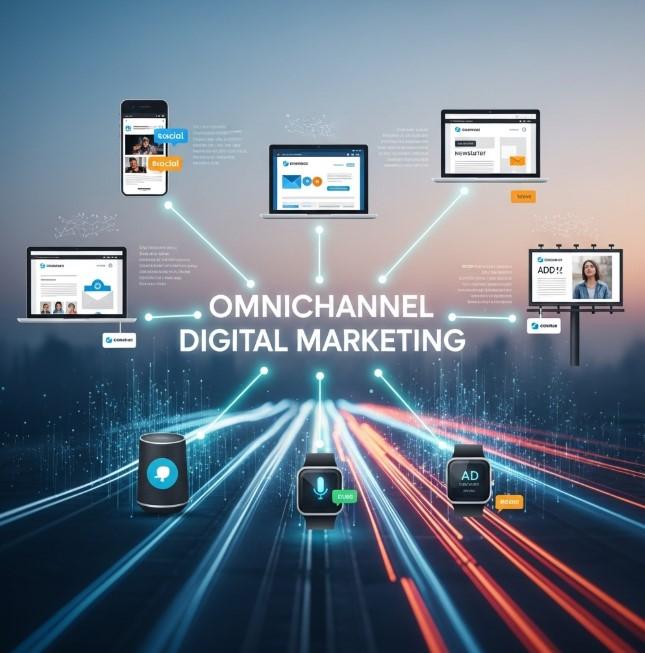Omnichannel Digital Marketing: How to Build Consistency Across Every Touchpoint

In 2025, B2B buyers are more connected than ever—researching vendors across email, social platforms, search engines, websites, and even virtual events before making a decision. With so many touchpoints, the challenge for digital marketers is clear: how do you create a consistent, seamless experience across every channel?
The answer lies in omnichannel digital marketing. Unlike multichannel, which focuses on being present everywhere, omnichannel ensures integration and consistency—so no matter where a prospect engages, they experience the same message, value, and brand identity.
This blog will explore what omnichannel digital marketing means, why it matters for B2B brands, and how to build a future-ready omnichannel strategy.
What is Omnichannel Digital Marketing and Why It Matters
Omnichannel digital marketing is the practice of delivering a unified, customer-centric experience across all digital touchpoints. It’s not about simply running campaigns on LinkedIn, email, and Google Ads separately—it’s about ensuring these platforms work together in harmony.
Why it matters for B2B in 2025:
- Buyers expect consistency across 6–10 touchpoints before engaging sales.
- Disconnected campaigns create confusion and lower trust.
- A unified approach improves engagement, pipeline velocity, and ROI.
According to Salesforce, 76% of B2B buyers expect consistent interactions across departments and channels—but only 54% of businesses deliver it. That gap represents a massive opportunity.
Key Challenges in Omnichannel Digital Marketing
- Fragmented Data – Marketing data lives in silos across platforms, making integration difficult.
- Inconsistent Messaging – Without clear alignment, campaigns on different channels feel disjointed.
- Technology Gaps – Legacy tools often fail to support cross-channel orchestration.
- Resource Intensity – Creating channel-specific content while maintaining consistency is demanding.
- Measuring ROI Across Channels – Attribution becomes complex in multi-touch journeys.
Proven Strategies to Build an Omnichannel Digital Marketing Framework
1. Centralize Customer Data
Use Customer Data Platforms (CDPs) or marketing automation tools to unify insights from email, social, website analytics, and CRM into a single source of truth.
2. Develop a Unified Messaging Framework
Define your brand’s core positioning, value propositions, and tone. This ensures every email, ad, or post reinforces the same story.
3. Leverage Personalization at Scale
With AI-driven personalization engines, marketers can deliver context-aware experiences across multiple channels—for example, showing a LinkedIn ad that mirrors the content a user engaged with in an email.
4. Adopt Marketing Automation for Orchestration
Automation tools ensure timely, sequenced campaigns—like nurturing a prospect who downloads a whitepaper with personalized emails followed by retargeting ads.
5. Measure and Optimize with Multi-Touch Attribution
Instead of giving credit to the first or last touch, adopt multi-touch attribution models to see how each channel contributes to pipeline growth.
Future of Omnichannel Marketing in 2025 and Beyond
Omnichannel strategies will only grow more sophisticated, with trends including:
- Conversational AI integration for real-time cross-platform engagement.
- Interactive experiences (like shoppable webinars and AR-powered product demos).
- Predictive engagement models that proactively push the right content at the right time.
- Full funnel visibility with AI-driven attribution, making ROI measurement more precise.
In the coming years, B2B digital marketing success will depend not just on being everywhere, but on being everywhere consistently.
Pro Tips for Digital Marketers
- Audit your customer journey quarterly to identify gaps in consistency.
- Use content repurposing to maintain alignment across formats (e.g., turn a webinar into blogs, LinkedIn posts, and email snippets).
- Create account-level engagement maps for ABM-aligned omnichannel execution.
- Align your sales enablement content with marketing campaigns for consistency beyond digital channels.
Conclusion
Omnichannel digital marketing isn’t just a buzzword—it’s the new baseline for B2B engagement. By integrating data, messaging, and technology, businesses can deliver seamless experiences that build trust and accelerate conversions.
In 2025, buyers won’t just remember the brand that shows up everywhere—they’ll remember the brand that shows up consistently and meaningfully everywhere.
- Art
- Causes
- Crafts
- Dance
- Drinks
- Film
- Fitness
- Food
- Giochi
- Gardening
- Health
- Home
- Literature
- Musica
- Networking
- Altre informazioni
- Party
- Religion
- Shopping
- Sports
- Theater
- Wellness


